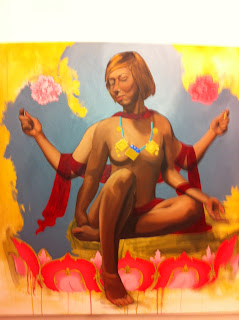/EXHIBITION TEXT
BATISTA’S DIVINE INSPIRATION: AN INVITATION TO THE OTHER SIDE /MARK ALLARD
Creating divine icons can be a meritorious act that nourishes the spirit and brings about the existence of deities and good luck. Calgary artist Brian Batista tests the possibility of sublime experience in art. His work, DIVINE INSPIRATION, blends sacred geometry with historical references to re-imagine traditional images and cleverly conceptualize contemporary life in terms of Vedic deities and sublime mystical revelation.
The development of Vedic deities was a fusion of ideas from invading Aryan tribes - from the region of Iran, and the indigenous people of northern India. The Aryan herdsmen were less interested in rural deities and stressed the adoration of natural phenomena. The sun (Surya) and fire (Agni) were personifications of divinity. As A. A. MacDonnell describes, "true gods of Veda are glorified human beings, inspired with human motives and passions. Born like men, but immortal."1
Deities from the succeeding RigVedic era were less secure, gaining or losing prestige, and new ones emerged, replacing those that had become obsolete. Indra was considered the almighty powerful God and became Prajapati, the creator and preserver of the universe, and would be identified with Brahma in the post Vedic period. The new Vedic deities would influence Buddhism, eastern mysticism, and future religious thought generally.
DIVINE INSPIRATION began with Batista choosing models to represent various Vedic deities. He photographs them in traditional poses and then translates the photographs on canvas using Vedic mathematics. His images are rendered differently from the one-dimensional flat Tibetan style by Batista’s use of a more Western Renaissance style. They bear bright, abstract colors and deeply representational forms and shadows. Established traditions are maintained where figures hold ritual implements to signify specific identities and narratives.
Vedic deities are very often male, but Batista intentionally confuses representations of gender to achieve a visceral effect. He hopes “to transcend representational art by creating a mystical experience” and “shake a person to their core.” He wants to “delight the eyes and ignite imaginations, with the intention of inspiring beauty, reverence, and curiosity.” Gender confusion is Batista’s springboard for achieving these goals, as is Batista’s use of chromo-depth, a technique wherein the colors are coded by depth. With the use of special glasses, the two-dimensional images become multidimensional, causing the paintings themselves to come alive.
The pieces in DIVINE INSPIRATION are bold and colorful acrylic and oil paintings on canvas, with gold and silver throughout. The largest one measures 5ft x 8ft though they all seem to be grandiose. They are hung high on the gallery walls so that viewers must look up to find their eyes. When contact is made the image meets the viewer’s gaze with a sparkle of reflective metallic elements, but only the most perceptive viewer will notice this secret message. Bright colors, textures, and patterns add depth and broaden perspective, fusing traditional Eastern iconography with contemporary Western influences. Batista intends the fusion to initiate an immediate embodied response of awe and wonder, as one might imagine the original deities did.
How we imagine ourselves has much to do with how we imagine divinity. DIVINE INSPIRATION invites us across divides between here and there and now and then. The viewer may find him- or herself on the other side of conventional and historical standards, experiencing new heights in modern spirituality. In the company of Batista’s images, one discovers, or is reminded, that spirituality can come from within. These paintings remind us that limited, skewed, and biased views of divinity affect our ability to experience ourselves as full bearers of the divine image. DIVINE INSPIRATION celebrates our potential and offers a profoundly contemporary reinvention of sublime Vedic and mystical revelation.
1 Arthur A. McDonnell, Vedic Mythology (Delhi: Motilal Banersidass Publishers PVT. LTD., 2002, first edition 1898) page
2. In-person interview between Allard and Batista in the artist’s studio, September 22, 2012, Calgary, Alberta.
3. Also from September 22, 2012 interview, as above.
/WRITER BIO
/MARK ALLARD describes himself as a “guerrilla journalist,” referencing his time with the Zapatistas in Mexico, paramilitaries in Northern Ireland, and a three-month sojourn into off-the-radar Ethiopia. His first novel, Regressions, was released in October 2012.













.JPG)









.JPG)
.JPG)
.JPG)
























.JPG)